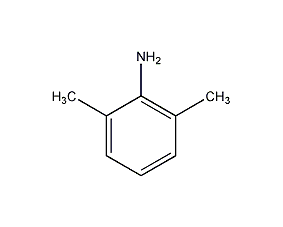
Structural formula
| Business number | 01Y8 |
|---|---|
| Molecular formula | C8H11N |
| Molecular weight | 121 |
| label |
2-amino-m-xylene, 2,6-Dimethylaniline, 2,6-Dimethylaniline, 2-Amino-m-xylene, o-Xylidine, Aromatic nitrogen-containing compounds and their derivatives |
Numbering system
CAS number:87-62-7
MDL number:MFCD00007747
EINECS number:201-758-7
RTECS number:ZE9275000
BRN number:636332
PubChem number:24862784
Physical property data
1. Properties: light yellow to orange liquid [1]
2. Melting point (℃): 10~12[ 2]
3. Boiling point (℃): 214 (98.5kPa); 216[3]
4. Relative density (water =1): 0.98[4]
5. Relative vapor density (air=1): 4.18[5]
6. Octanol/water partition coefficient: 1.84~1.96[6]
7. Flash point (℃): 97 (CC) [7]
8. Explosion upper limit (%): No data yet
9. Explosion lower limit (%): 1.5[8]
10. Solubility: Insoluble in water, soluble in ethanol and ether. [9]
Toxicological data
1. Acute toxicity
Rat caliber LD50: 8400mg/kg; mouse caliber LD50: 707mg/kg;
2. Teratogenicity
Salmonella: 50umol/plate; E. coli: 39ug/well; Hamster ovary: 1mg/L;
3. Other multiple dose toxicity data
Rat caliber TDL0: 3150 mg/ kg/20D-C;
Rat caliber TDL0: 6200 mg/kg/2W-I; Rat caliber TDL0: 13300 mg/kg/4W-I;
Rat Caliber TDL0: 20150 mg/kg/13W-I;
4. Chronic toxicity/carcinogenicity:
Rat caliber TDL0: 107mg/kg/2Y-C;
5. Acute toxicity[10] LD50: 840mg/kg (rat oral)
6. Irritation No data yet
7. Mutagenicity [11] Microbial mutagenicity: Salmonella typhimurium 50 μmol/dish. Cytogenetic analysis: Hamster ovary 1g/L. Sister chromatid exchange: Hamster ovary 301mg/L
8. Carcinogenicity [12] IARC Carcinogenicity Comment: Group 2B, Yes to humans Possible carcinogen.
Ecological data
1. Ecotoxicity[13] EC50: 330mg/L (48h) (Tetrahymena pyriformis); 26.5mg/L (30min) (Photobacterium , Microtox test)
2. Biodegradability[14]
Aerobic biodegradation (h): 672~ 4320
Anaerobic biodegradation (h): 2688~17280
3. Non-biodegradability[15]
The half-life of photooxidation in water (h): 62.4~3480
The half-life of photooxidation in air (h): 0.33~3.3
4. Other harmful Effect[16] This substance is harmful to the environment and should be specially�Pay attention to the pollution of water bodies.
Molecular structure data
1. Molar refractive index: 40.13
2. Molar volume (cm3/mol): 124.2
3. Isotonic specific volume (90.2K ): 308.3
4. Surface tension (dyne/cm): 37.9
5. Polarizability (10-24cm3): 15.91
Compute chemical data
1. Reference value for hydrophobic parameter calculation (XlogP): None
2. Number of hydrogen bond donors: 1
3. Number of hydrogen bond acceptors: 1
4. Number of rotatable chemical bonds: 0
5. Number of tautomers: none
6. Topological molecule polar surface area 26
7. Number of heavy atoms: 9
8. Surface charge: 0
9. Complexity: 80.6
10. Number of isotope atoms: 0
11. Determine the number of atomic stereocenters: 0
12. Uncertain number of atomic stereocenters: 0
13. Determine the number of chemical bond stereocenters: 0
14. Number of uncertain chemical bond stereocenters: 0
15. Number of covalent bond units: 1
Properties and stability
1. This product is toxic. LD50840mg/kg (rat oral). This product can cause methemoglobinemia and cause tissue hypoxia; it has strong damage to the central nervous system and liver, but has a weak effect on blood. Very easily absorbed through skin. Can cause dermatitis. Production should be tightly enclosed and provide adequate local exhaust. Mechanize and automate as much as possible. Safety showers and eyewash facilities are provided. Wear a filter-type gas mask when you may be exposed to its vapors. Wear safety glasses, protective clothing, and rubber gloves.
2. Stability[17] Stable
3. Incompatible substances[18] Acids, acid anhydrides, acid chlorides, strong oxidants, chloroform, halogens
4. Conditions to avoid contact [19] Heating
5. Polymerization hazard[20] No polymerization
Storage method
1. Storage precautions[21] Store in a cool, ventilated warehouse. Keep away from fire and heat sources. Keep container tightly sealed. They should be stored separately from oxidants, acids, halogens, and food chemicals, and avoid mixed storage. Equipped with the appropriate variety and quantity of fire equipment. The storage area should be equipped with emergency release equipment and suitable containment materials.
2. Packaging uses wooden crates outside small opening steel drums, screw-top glass bottles, iron-topped glass, plastic bottles or metal drums (cans); ampoules outside wooden crates. Store in a cool, ventilated warehouse. Keep away from fire and heat sources. Protect from direct sunlight. Keep container tightly sealed. It should be stored separately from oxidants, acids, and food chemicals. When handling, load and unload with care to prevent damage to packaging and containers.
Synthesis method
1. The synthetic routes of this product mainly include 2,6- dimethylphenol aminolysis, o-methylaniline alkylation, and aniline methylation method, m-xylene disulfonation nitration method and m-xylene nitration reduction method, etc.

Purpose
1. This product is an intermediate for pesticides, pharmaceuticals and veterinary drugs. In the pesticide industry, it is used to produce high-efficiency fungicides metalaxyl, furalaxyl, furamide, formamide, benalaxyl, vicinicide vitriol, and high-efficiency and low-toxicity selective herbicides isobutachlor, teradol (dimethylchloride) amines) and imidazole amide, etc.; in the pharmaceutical industry, it is used to produce anesthetics such as lidocaine hydrochloride, bupivacaine hydrochloride, acaine hydrochloride, tocainium, and leucine. In addition, it is also a raw material for the production of the veterinary drug Jingsongling.
2. Used in organic synthesis and manufacturing dyes. [22]

 微信扫一扫打赏
微信扫一扫打赏

